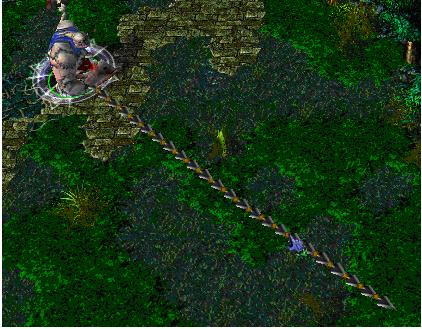Description
In the game of DotA, Pudge’s meat hook is actually the most horrible thing for most of the heroes. The hook is made up of several consecutive metallic sticks which are of the same length.

Now Pudge wants to do some operations on the hook.
Let us number the consecutive metallic sticks of the hook from 1 to N. For each operation, Pudge can change the consecutive metallic sticks, numbered from X to Y, into cupreous sticks, silver sticks or golden sticks.
The total value of the hook is calculated as the sum of values of N metallic sticks. More precisely, the value for each kind of stick is calculated as follows:
For each cupreous stick, the value is 1.
For each silver stick, the value is 2.
For each golden stick, the value is 3.
Pudge wants to know the total value of the hook after performing the operations.
You may consider the original hook is made up of cupreous sticks.

Now Pudge wants to do some operations on the hook.
Let us number the consecutive metallic sticks of the hook from 1 to N. For each operation, Pudge can change the consecutive metallic sticks, numbered from X to Y, into cupreous sticks, silver sticks or golden sticks.
The total value of the hook is calculated as the sum of values of N metallic sticks. More precisely, the value for each kind of stick is calculated as follows:
For each cupreous stick, the value is 1.
For each silver stick, the value is 2.
For each golden stick, the value is 3.
Pudge wants to know the total value of the hook after performing the operations.
You may consider the original hook is made up of cupreous sticks.
Input
The input consists of several test cases. The first line of the input is the number of the cases. There are no more than 10 cases.
For each case, the first line contains an integer N, 1<=N<=100,000, which is the number of the sticks of Pudge’s meat hook and the second line contains an integer Q, 0<=Q<=100,000, which is the number of the operations.
Next Q lines, each line contains three integers X, Y, 1<=X<=Y<=N, Z, 1<=Z<=3, which defines an operation: change the sticks numbered from X to Y into the metal kind Z, where Z=1 represents the cupreous kind, Z=2 represents the silver kind and Z=3 represents the golden kind.
For each case, the first line contains an integer N, 1<=N<=100,000, which is the number of the sticks of Pudge’s meat hook and the second line contains an integer Q, 0<=Q<=100,000, which is the number of the operations.
Next Q lines, each line contains three integers X, Y, 1<=X<=Y<=N, Z, 1<=Z<=3, which defines an operation: change the sticks numbered from X to Y into the metal kind Z, where Z=1 represents the cupreous kind, Z=2 represents the silver kind and Z=3 represents the golden kind.
Output
For each case, print a number in a line representing the total value of the hook after the operations. Use the format in the example.
Sample Input
1
10
2
1 5 2
5 9 3
Sample Output
Case 1: The total value of the hook is 24.
题目大意:给你T组测试数据,每组有n,m表示n个棒,每个棒起始都是铜棒,值为1。银棒为2,金棒为3。现在要让区间ui,vi内的棒变为wi类型的棒,问你最后棒的总值是多少。
解题思路:延迟标记。首先在区间更新时,应该保证要更新的那段区间内的结点的值是正确的,然后做延迟标记。在下放标记的时候,应该保证下放后的结点的值是正确的。这样在询问的时候,才能向上推出正确的结果。
#include<stdio.h>
#include<algorithm>
#include<string.h>
using namespace std;
#define mid (L+R)/2
#define lson rt*2,L,mid
#define rson rt*2+1,mid+1,R
const int maxn = 120000;
struct SegTree{
int val;
int lazy;
}segs[maxn*4];
void PushUp(int rt){
segs[rt].val = segs[rt*2].val + segs[rt*2+1].val;
}
void PushDown(int rt,int L,int R){
if(segs[rt].lazy){
segs[rt*2].lazy = segs[rt].lazy;
segs[rt*2+1].lazy = segs[rt].lazy;
segs[rt*2].val = (mid - L+1)*segs[rt].lazy;
segs[rt*2+1].val = (R-mid) * segs[rt].lazy;
}
segs[rt].lazy = 0;
}
void buildtree(int rt,int L,int R){
segs[rt].lazy = 0;
if(L == R){
segs[rt].val = 1;
return ;
}
buildtree(lson);
buildtree(rson);
PushUp(rt);
}
void Update(int rt,int L,int R,int l_ran,int r_ran,int _v){
if(l_ran <= L && R <= r_ran){
segs[rt].val = _v * (R-L+1);
segs[rt].lazy = _v;
return;
}
PushDown(rt,L,R);
if(l_ran <= mid){
Update(lson,l_ran,r_ran,_v);
}
if(r_ran > mid){
Update(rson,l_ran,r_ran,_v);
}
PushUp(rt);
}
int main(){
int T, n, m, cas = 0;
scanf("%d",&T);
while(T--){
scanf("%d%d",&n,&m);
buildtree(1,1,n);
int u,v,w;
for(int i = 1; i <= m; i++){
scanf("%d%d%d",&u,&v,&w);
Update(1,1,n,u,v,w);
}
printf("Case %d: The total value of the hook is %d.
",++cas,segs[1].val);
}
return 0;
}